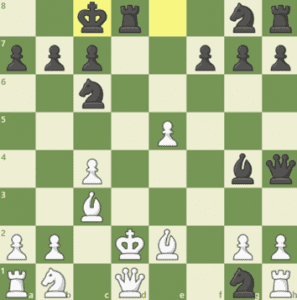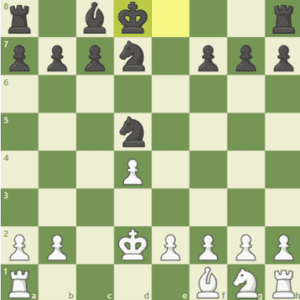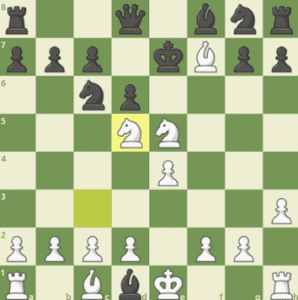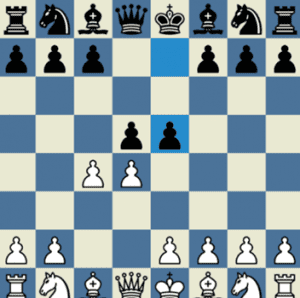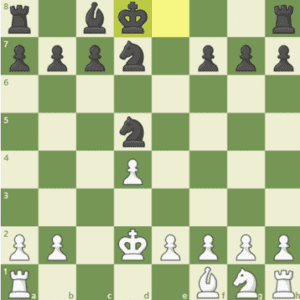Besides the obvious (ie: that moment where your opponent resigns from the board and you are triumphant), there are few moments in chess that are more satisfactory to the player than successfully baiting your opponent into a trap. Traps in chess are a broad category that refers to any move that tricks an opponent into a move that will make them lose a valuable piece. Traps can be done at any point in the game (the early game, the mid game, the end game, or to finalize a checkmate). There are dozens of traps that a chess player can utilize, but this article will present 5 simple ones that you can use.
1) The Noah’s Ark Trap
This is a trap that is best utilized in the early or middle game, and it is used to force your opponent to lose (more often than not) their white-square bishop (which, of course, can be used to flank either your king or queen, depending on which side you’re playing as). This trap is typically done by the black side after the white player has attempted the Ruy Lopez opening, which is as follows:
The Noah’s Ark trap, consequently, is as follows (make sure to follow along on your chess board):
- PE4 PE5, 2. nF3 nC6 3. Bb5 PA6 4. PA4 PD6 5. PD4 PB5 6. BB3 NXD4 7. NXD4 PXD4 8. QXD4 (this is the trap, a pawn sacrifice to lure out the queen) PC5 9. QD5 B6 10. QC6+ (check) BD7 11. QD5 PC4
Thus, black has successfully trapped white into losing either its queen or its bishop.
2) Cambridge Trap
The Cambridge trap is usually associated with the denial of a Queen’s Gambit (where the pawns in front of the bishop and queen are moved up to facilitate rapid aggression).
- d4 d5 2. c4 e6 3. c3 f6 4. g5 bd7 5. cxd5 exd5 6. xd5 xd5! 7. xd8 b4+ This move is the clincher, white must move to save the queen, which springs the trap. 8. d2 xd2+ 9. xd2 xd8
3) Legal
Not “legal” of course, but “legal” with an accent over the A, named after the French Sire de Legal. This one is a bit risky and (Dare I say) I bit off putting, since it requires a queen sacrifice. But when done properly this can force a surprisingly quick checkmate.
- PE4 PE5 2. NC3 NF6 3. BC4 PD6 4. NC3 BG4 5. PH3 BH5 (this is where the black player is forced to choose between losing a bishop or not, hopefully they choose to retreat). 6. NXE5 BXD1 7. BXF7+ KE7 9. ND5#
4) Lasker
Named after the second recognized world champion (Emmanuel Lasker), this trap is also unique in that it is one of the few strategies that involves a pawn under promoting itself to a knight, rather than the ubiquitous queen.
This is another trap that involves black reacting to white’s Queen’s Gambit, and is based on the black Albin Counter-gambit, which is shown below.
The Lasker trap follows from here:
- d4 d5 2. c4 e5 The aggressive Albin Countergambit. 3. dxe5 d4 The pawn wedge on d4 deprives the b1-knight from going to the natural c3-square. 4. e3 (This is a mistake you hope white makes) d2 dxe3! 6. xb4?? (Again, you are hoping to bait white into a mistake). exf2+ 7. e2 fxg1 8. e1h4+ 9. d2 c6 Black is winning! 10. c3 g4 11. e2 O-O-O+
5) Rubinstein Trap
The last of the traps I will be teaching you today is the Rubinstein Trap, named after another legend of the chess game (that of course being Akiba Rubinstein). This one is risky (and a smart opponent can negate it to a mere pawn sacrifice), but it can lead to trapping the queen if the opponent gets greedy (which is of course what you want).
Pd4 Pd5 2. Pf3 Pf6 3. Pc4 Pe6 4. Pg5 bd7 (This is the Queen’s Gambit Declined). 5. Pe3 Pe7 6. Pc3 O-O 7. Pc1 Pe8 8. Pc2 Pa6 9. cxd5 exd5 10. Pd3 Pc6 11. O-O e4 12. f4 f513. Pxd5 White has won a critical central pawn. Black cannot recapture due to the queen being trapped. 13… cxd5?? 14. Pc7, and it is here that the black queen will be trapped.
Try these for yourself in your own game!
Josh Freimark



